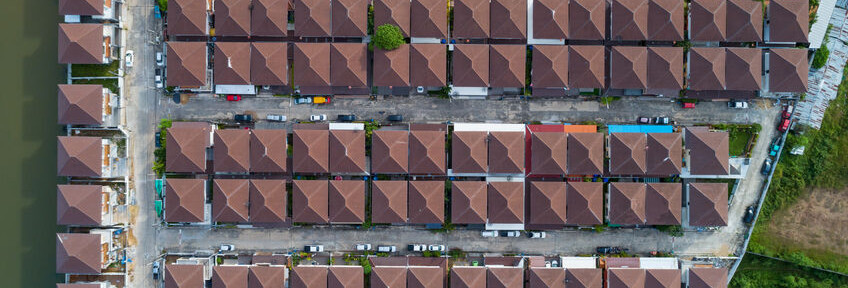
Nothing stays new. Over time, things age, including infrastructure, and HOAs need to be prepared for this. Many HOAs run into problems because of aging infrastructure issues. Oftentimes, by the time HOAs realize there is an issue, they don’t have enough funding available, so they have temporary fixes completed. Sometimes these issues also get put aside until they grow into problems that can’t be ignored. Either situation can end up costing the HOA more money in the long run. This is why we often stress the importance of regular maintenance because issues only grow more costly when they’re not caught and taken care of early on.
The FCAR Researches Aging Infrastructure
Because aging infrastructure has been a problem for many HOAs, the Foundation for Community Association Research (FCAR) did some research in 2018 to find some answers that could help HOAs move forward. They created a task force “comprising attorneys, reserve specialists, engineers, insurance providers, managers, and bankers, to determine what issues are the most prevalent in failing physical components, and—especially—how associations can prepare themselves to address and resolve these issues when they inevitably arise.” They surveyed “CAI managers, board members, and contractors in community associations across the U.S.” The survey revealed a lot of data. Concerningly, “More than three-quarters (81%) of survey respondents reported encountering unanticipated and unplanned-for infrastructure issues over a recent three-year period.” This result is a reminder of how important preventative maintenance and comprehensive reserve studies are to an HOA’s success.
The Main Issues Reported in the Study
What were the “majority of issues reported by survey respondents? Water intrusion in windows and siding, deteriorating balconies or fences, or failing pipes or roofing, among a variety of other problems.” These results did not surprise those on the task force. The report states that “in many cases, the underlying cause of the problem was known, however, the community delayed correcting the actual cause because association decision-makers wanted to attempt a minor repair to control the damage, or they needed time to develop a financial plan for repairs.” They mentioned how deferring maintenance can end up “costly for the community,” as we would agree with. Other than water intrusion issues, about “36% of respondents experienced plumbing or electrical system issues in the most recent three-year period…” and “30% relayed other initially unidentified problems with components like roofs and roof sheathings, building envelope and structure, and recreational facilities.”
The Importance of Regular Comprehensive Reserve Studies
The research also revealed that some of these unexpected things were missed in the “most recent reserve study.” There are three types of reserve studies that can be done, some items could get missed if a comprehensive reserve study isn’t completed. Reserve studies should also be completed often, at least every three years. It’s equally essential that these studies are done by a reserve specialist. Following this procedure can help reduce the chance of running into unexpected costly issues that require special assessments. HOAs will have more knowledge about how much should be in their reserve funds so there’s less chance of them being caught off guard.
How to Get Homeowners on Board With Expenses
Whether HOAs need to increase fees or initiate special assessments, there’s an important component in getting homeowners committed to the cause. That is communication. We could have told you this before reading the research since it’s something that we hold near and dear to our hearts. The research only further backed our beliefs. According to the study, “homeowners and residents were more receptive and supportive of major infrastructure repairs when they were given the opportunity to learn—in advance—about the scope and costs of the project from experts, like the engineers and contractors who had specific knowledge of the damage and how to fix it.”
Additional Lessons to Take With You
Many involved in HOAs had to learn the hard way about the importance of addressing issues with aging infrastructures. One of the case studies included in the report involves an issue that arose at the “University Towers Condominiums in New Haven, Conn.” You can read all about it in “Breaking Point: Examining Aging Infrastructure in Community Associations.” “Kate Bowman, CMC, the on-site manager” talks about the importance of communication with homeowners. The study also talks about lessons that were learned through the experience: “Make sure board members are educated on reserve studies and why funding reserves sufficiently is necessary. … Be vigilant with inspections and keep up with code issues. … Don’t shirk preventive maintenance. … Take the time to identify a qualified engineer and project manager.” These lessons are good ones for any HOA board member to remember as they move forward. Let’s quickly talk about that last point… The need to hire the right contractor was mentioned in the report more than once. Finding the right contractor can make all of the difference when it comes to addressing concerns correctly, timely, and at the right price point. So, be sure to vet your vendors carefully. And let’s not forget the importance of aligning yourself with a great property management company.
We know that aging infrastructure is an ongoing issue for HOAs, but thankfully, when you work with PMI, we can help address these issues. We work with trusted vendors, increase HOA transparency, improve communication, and prioritize maintenance needs. If you’d like to learn more about what the report found, we encourage you to give it a full read. And, please reach out to us at PMI by emailing {{account:email}} if you’d like to learn more about what we have to offer.



